

Freud Corner is the name used for the place within Golders Green Crematorium in North London, where the funerary urns of Sigmund Freud and many other members of the Freud family are deposited.


Freud Corner is the name used for the place within Golders Green Crematorium in North London, where the funerary urns of Sigmund Freud and many other members of the Freud family are deposited.
When writing his will in 1919, Sigmund Freud stated that he wanted to be cremated as it was a cheaper and easier process than conventional burial. [1] Freud died at 3 am [2] on 23 September 1939. Three days later, his body was cremated at Golders Green Crematorium. His son Ernst Freud had organised the funeral arrangements, and Harrods of Knightsbridge acted as funeral directors. [2] After the funeral, Freud's ashes were deposited in an ancient Greek bell krater from the 4th century BC which came from his large collection of over 2000 antiquities [2] (see below). The ancient bell krater, now serving as a funerary urn, was later placed atop a black marble plinth, designed by Ernst Freud [3] and erected in the crematorium's Ernest George Columbarium. This building, built 1922–1928, was designed after Ernest George's death by Alfred Yeates in Romanesque Revival style [4] as a three-sided building, grouped around a central lawn and a lily pond.
After Martha Freud's death in 1951, her ashes were also placed into the ancient bell krater. [5] In the decades that followed, many more members of the Freud family were cremated at Golders Green: Robert Hollitscher (Sigmund Freud's son-in-law), who died in 1959; Jean-Martin Freud (Sigmund Freud's son), who died in 1967; Oliver Freud (Sigmund Freud's son), who died in 1969; Ernst Freud (Sigmund Freud's son), who died in 1970; Henny Freud (née Fuchs, second wife of Oliver Freud), who died in 1971; Mathilde Hollitscher (Sigmund Freud's daughter, widow of Robert Hollitscher), who died in 1978; Anna Freud (Sigmund Freud's daughter), who died in 1982; Colin Peter Freud (Sigmund Freud's great-grandson), who died in 1987; Annette Freud (née Krarup, wife of Anton Walter Freud), who died in 2000; Anton Walter Freud (Jean-Martin Freud's son), [6] who died in 2004; and Margaret Freud (Jean-Martin Freud's partner in England, whom he later adopted). [7] Friends of the Freud family whose ashes rest with them are Lajos Lévy, [8] who died in 1961; his widow Katá, [9] who died in 1969; Dorothy Burlingham, who died in 1979; Jula Weiss, [10] who died in 1994; and Tini Maresch, [11] who died in 1996. The vessels containing their ashes are today kept on three-tiered white stone shelves erected on either side of the plinth with Sigmund and Martha Freud's funerary urn.
On New Year's Day 2014, Golders Green Crematorium staff discovered that burglars had apparently broken into the Ernest George Columbarium overnight and smashed the ancient bell krater containing Sigmund and Martha Freud's ashes in the attempt to steal the vessel. The severely damaged urn was afterwards temporarily moved to a secure location. [12] [13] Today the restored urn is protected by a case of special glass and guarded. Visits to Freud Corner can only be made in the company of a member of Golders Green Crematorium's staff and after reporting to reception. [14]
Freud Corner occupies a window niche, built in red brick, inside the crematorium's Ernest George Columbarium. In the centre of this niche stands a black marble plinth with the funerary urn of Sigmund and Martha Freud on its top. Their names, dates of birth and death are inscribed on the plinth in gold lettering. The vessel containing their ashes is a sealed [2] ancient Greek bell krater, likely made in Apulia, [2] painted with Dionysian scenes. [5] One of these images depicts Dionysus with a maenad. It is not known why, when, and by whom the decision was made to place Freud's ashes in this vessel; there is no mention of such an intention in any of Freud's correspondence, in his last will, or in any subsequent family correspondence. [2] Freud had received this 2,300-year-old item from Princess Marie Bonaparte for his 75th birthday on 6 May 1931. Freud loved the piece, writing to Marie Bonaparte about it: "...it is a pity one cannot take it into one's grave." [15] He used to keep the bell krater on display in his study at Berggasse 19, Vienna, until his forced move to the United Kingdom in June 1938.
The white stone shelf to the left of the black marble plinth with the ancient Greek bell krater holds nine urns, as of 2021 [update] . While most of these are brick-sized brownish metal containers inscribed with the name, date of birth and date of death of the deceased, both the ashes of Colin Peter Freud and of Margaret Freud are kept in wooden caskets. The ashes of Dr. Lajos Lévy and his wife Katá are in the same vessel. The cremated remains of the following rest here:
| Anna Freud (1895–1982) Ernst Freud (1892–1970) | Oliver Freud (1891–1969) Dorothy Burlingham (1891–1979) |
| Colin Peter Freud (1956–1987) | Jula Weiss (1905–1994) |
| Margaret Freud | Dr. Lajos Lévy (1875–1961) and Katá Lévy (1883–1969) |
The white stone shelf to the right of the black marble plinth currently holds four urns. The ashes of Tini Maresch are in a brick-sized brownish metal container like those already mentioned. So are those of Mathilde Hollitscher (née Freud) and her husband Robert, which are in the same vessel. The ashes of Anton Walter Freud and his wife Annette share a large wooden casket, while the ashes of Henny Freud are kept in a stone urn made of granite. The cremated remains of the following rest here:
| Robert Hollitscher (1875–1959) and Mathilde Hollitscher (née Freud, 1887–1978) | |
| Annette Freud (née Krarup, 1925–2000) and Anton Walter Freud (1921–2004) | |
| Henny Freud (née Fuchs, 1892–1971) | |

Golders Green Crematorium and Mausoleum was the first crematorium to be opened in London, and one of the oldest crematoria in Britain. The land for the crematorium was purchased in 1900, costing £6,000, and the crematorium was opened in 1902 by Sir Henry Thompson.
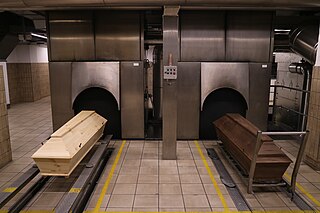
Cremation is a method of final disposition of a dead body through burning.

A bier is a stand on which a corpse, coffin, or casket containing a corpse is placed to lie in state or to be carried to the grave or mausoleum in a cemetery. If a funeral service is followed by cremation, the coffin or casket would be transported to a crematorium or crematory. In some cases, ashes inside an urn are placed into a columbarium.

A columbarium, also called a cinerarium, is a structure for the reverential and usually public storage of funerary urns holding cremated remains of the dead. The term comes from the Latin columba (dove) and originally solely referred to compartmentalized housing for doves and pigeons, also called dovecotes.

The Samadhi of Ranjit Singh is a 19th-century building in Lahore, Pakistan that houses the funerary urns of the Sikh Maharaja Ranjit Singh. It is located adjacent the Lahore Fort and Badshahi Mosque, as well as the Gurdwara Dera Sahib, which marks the spot where the fifth guru of Sikhism, Guru Arjan, died. Its construction was started by his son and successor, Maharaja Kharak Singh, after the ruler's death in 1839, and completed nine years later. It overlooks the Hazuri Bagh, built by Ranjit Singh, to its south.
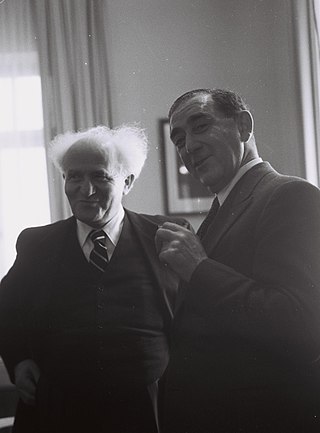
Simon Marks, 1st Baron Marks of Broughton, was an English retail businessman and baron, the son of Michael Marks, the co-founder of major British multinational company Marks & Spencer.
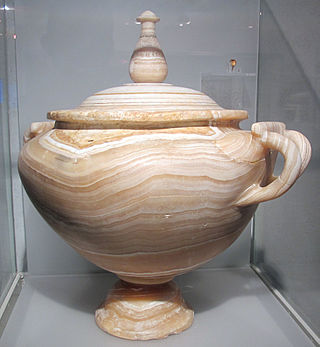
An urn is a vase, often with a cover, with a typically narrowed neck above a rounded body and a footed pedestal. Describing a vessel as an "urn", as opposed to a vase or other terms, generally reflects its use rather than any particular shape or origin. The term is especially often used for funerary urns, vessels used in burials, either to hold the cremated ashes or as grave goods, but is used in many other contexts.

The San Francisco Columbarium & Funeral Home is a columbarium owned and operated by Dignity Memorial, located at One Loraine Court, near Stanyan and Anza Streets, just north of Golden Gate Park in San Francisco, California. Built in 1898 by architect Bernard J.S. Cahill, the copper-domed Columbarium is an example of neoclassical architecture. It is the only non-denominational burial place within San Francisco's city limits that is open to the public and has space available.

Cremation is a method used to dispose of the deceased in the Christian world despite historical opposition to the practice.

Deaths in Singapore offset the population increase from live births. In 2007, 17,140 people in Singapore died from various causes. The death rate was 4.5 deaths per 1,000 of the population. There are strict regulations surrounding death and treatment of the body after death.
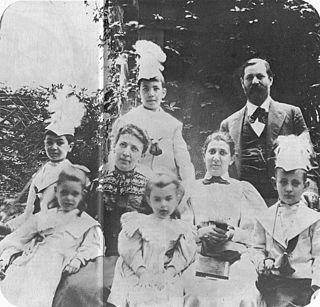
Ernst L. Freud was an Austrian-born British architect and the fourth child of Austrian psychoanalyst Sigmund Freud and his German-born wife Martha Bernays. In honour of his wife, Ernst Freud added the initial L. to his name when he married in early 1920, making the middle initial stand for Lucie and not Ludwig as is often assumed.

The Derveni Krater is a volute krater, the most elaborate of its type, discovered in 1962 in a tomb at Derveni, not far from Thessaloniki, and displayed at the Archaeological Museum of Thessaloniki. Weighing 40 kg, it is made of a bronze with a high tin content of about 15%, which endows it with a superb golden sheen without use of any gold at all. It is dated to the 4th century BC, and was probably made in Athens. Large metalwork vessels are extremely rare survivals in Ancient Greek art, and the Derveni Krater is the outstanding survival from Hellenistic art, as the Vix Krater is from the Archaic period.

Martha Bernays was the wife of Austrian psychoanalyst Sigmund Freud.
Anton Walter Freud was a chemical engineer and a member of the Royal Pioneer Corps and the British Special Operations Executive. He was a grandson of Sigmund Freud and escaped with him and other family members from Vienna after the Anschluss.

Woking Crematorium is a crematorium in Woking, a large town in the west of Surrey, England. Established in 1878, it was the first custom-built crematorium in the United Kingdom and is closely linked to the history of cremation in the UK.

Birmingham Crematorium is a crematorium in the Perry Barr district of Birmingham, England, designed by Frank Osborne and opened in 1903. A columbarium was added in 1928. The crematorium is now owned and operated by Dignity plc.
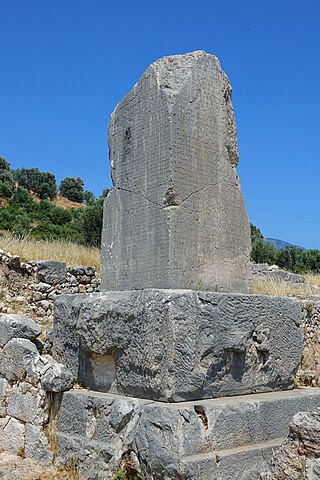
The theme of death within ancient Greek art has continued from the Early Bronze Age all the way through to the Hellenistic period. The Greeks used architecture, pottery, and funerary objects as different mediums through which to portray death. These depictions include mythical deaths, deaths of historical figures, and commemorations of those who died in war. This page includes various examples of the different types of mediums in which death is presented in Greek art.
Three extensive underground collective burial columbaria were discovered at Vigna Codini in the mid-nineteenth century, near the Aurelian Walls between the via Appia and via Latina in Rome, Italy. Although this area on the outskirts of Rome was traditionally used for elite burials, these columbaria that emerged in the Augustan era seem to have been reserved for non-aristocratic individuals, including former slaves. Not to be confused with the later phenomenon of catacomb inhumations, these subterranean chambers contained niches for cremation urns. The columbaria at Vigna Codini are among some of the largest in Rome.

Feuerhalle Simmering is a crematorium with attached urn burial ground in the Simmering district of Vienna, Austria. It lies at the end of an alley, directly opposite Vienna Central Cemetery's main gate.

Sellia Epyre was a Roman craftswoman who operated a business on the Via Sacra producing embroidery in gold thread. She is known from two funerary inscriptions.